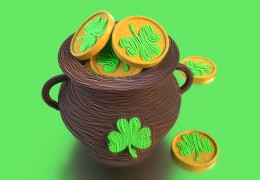
Discover how to make eco-friendly crafts with a 3D pen this St. Patrick's Day! Get inspired with various project...

However, even the most experienced and talented artists may find it challenging to use 3D pens to their maximum potential. This blog post will discuss 11 of the best life hacks to help you use your 3D pen to its fullest potential.
These 11 life hacks will help you master the techniques needed to use a 3D pen to its fullest potential. With dedication and regular practice, you’ll be able to do unique projects easily. So, start getting creative and have fun with 3D pens today!
Consider using guides, such as templates and grids, drawings, and tracing paper, to help define the 3D piece. This will make the drawing process more neat and efficient.
Find the proper template, stencil, image or just an excellent idea. If it is depicted on paper, prepare it for 3d pen drawing.
Apply masking tape on your paper to create the adhesive layer. Masking tape is semitransparent, allowing you to see your sketch through it. Moreover, masking tape prevents sticking paper to your masterpiece once the drawing is complete.
It’s a fabulous life hack; even many experts aren’t familiar with it. So, enjoy this secret method we share with you!
Before beginning any significant projects, doing a few simple warm-up sketches with your 3D pen is crucial.
This will help you get familiar with the process and understand the nuances of your particular pen. Doing warm-up sketches will also help you become more comfortable with the 3D pen, allowing you to create more intricate designs easily. Taking the time doing these warm-up sketches will be beneficial in the long run and help you get the most out of your 3D pen.
Selecting the appropriate filament colour before beginning a 3D pen drawing project is essential. This is because each filament colour will have different properties, and the project's result will depend on which colour you use.
Some filament colours may be more opaque, while others may have more sheen.
For example, a black filament gives a more subtle look than a brighter colour, and a metallic finish can create intense shapes and contours.
The filament colour can also affect the intensity of the colour in the resulting designs, and different filament colours may require different temperatures to achieve the desired effect. Considering all of these factors when planning a 3D pen drawing project is essential, as the choice of filament colour can significantly impact the result.
So, prepare all the colours of filament you need in advance to avoid distraction while creating.
Change the temperature to adjust the thickness of the lines. A temperature change of 5-10 °C will affect the thickness of the extruded plastic. Choose the best value for your plastic, or ask the filament manufacturer for information.
Keep in mind that there is also a connection between temperature and filament colour. The darker the colour, the higher the temperature should be. Often these changes are in the range of 5-10 °C, but even this slight change can impact the final result.
Make sure the material thickness is evenly distributed throughout the pattern. This will provide an even level of depth as well as an even 3D look that each of your layers achieves.
Or use this feature to achieve different textures for your 3D drawing. The choice is yours!
Set a comfortable drawing speed. If you set the speed too low but move the pen too fast, the plastic will not have time to melt, and the lines will be uneven and jerky.
Speed and temperature are also two interdependent parameters. The higher the drawing speed, the higher the temperature should be.
Slow speed is used to draw small objects such as eyes, fingers, or decorative patterns. High speed is used to paint large areas of your 3D object.
By changing the angle of the 3D pen and moving it at a constant speed, you can achieve precision and create stunning 3D designs.
With practice and patience, you can master the art of 3D pen design and create masterpieces.
With the right angle and a steady hand, you will create unique 3D art that everyone will admire.
Accuracy and precision are critical to creating the desired design. It's important to understand that the angle of your 3D pen can make a massive difference to the outcome of your design.
For example, if you hold your pen at an angle, almost horizontal, it will cause too much plastic to accumulate on the nozzle (tip) of your pen, causing it to stick and make it difficult to draw.
For beginners, we recommend holding the pen as vertically as possible to help them master basic drawing skills and develop their own style. Over time, you can tilt the handle slightly to get new results.
When doing this, remember that drawing from right to left or left to right can also affect the appearance of your lines. Try drawing to one side or the other, and you will immediately see the difference.
In addition, it is essential to move the 3d pen at a constant speed—moving too slowly can lead to sagging and blobs, and moving too fast can make it difficult to control and ruin the original idea.
Using 3D pens can be an enjoyable and creative experience, but it is essential to take regular breaks to ensure maximum comfort. To avoid overexertion and the discomforting symptoms of hand fatigue, taking breaks every 20–30 minutes is necessary. Doing this can make all the difference in feeling and enjoying the fullness of the creative experience without sacrificing comfort.
Taking breaks and consistently giving your hand a break will make crafting projects with 3D pens much more enjoyable and safer. Taking breaks will help to reduce the risk of hand fatigue and discomfort, allowing you to enjoy your 3D pen experience for longer. It is also essential to ensure that your 3D pen is in good condition and is not overheating.
Your 3D pens also need rest, and you should remove the filament and allow them to cool down every 30–40 minutes.
Before continuing to draw, we recommend loading transparent or light-colour filament to clean the nozzle.
Taking regular breaks will help to keep your 3D pen in optimal condition.
To ensure optimal operation and performance of your 3D pen, performing a routine nozzle cleaning is essential. Clogged nozzles can interfere with the flow of the filament and create poor-quality drawings.
If you use quality filaments and quality 3D pens and adjust your temperature and speed, the 3D pen nozzle will not be clogged.
In this case, you only need periodically to wipe the nozzle with napkins.
Heat the 3D pen to reach the melting temperature of the plastic, fold the tissue a few times and gently wipe the tip of the pen to get rid of the sticky plastic.
Be careful. Remember that the pen is hot, and you risk getting burned.
If you use incorrect speed, temperature, or poor-quality filament and get a clogged nozzle, you should clean it.
Use a needle or other thin object to clean the pen's nozzle periodically for the best results.
Keep in mind that cleaning the nozzle too frequently with a needle will cause micro-cracks to appear on the surface of the nozzle, which, is a long-time, will cause it to clog more often and fail to extrude straight lines of melted plastic.
Therefore, it is better to use high-quality materials and the proper settings.
Keeping your 3D pen clean and maintained can maximise its longevity and consistency.
Don't panic if you make a mistake while creating 3D art with a 3D pen! Most 3D artwork is easily adjustable and can be fixed with a few simple adjustments without much effort.
If you're using a 3D pen to create your masterpiece, small mistakes don't have to ruin your progress.
Depending on the error, the 3D pen might need to be heated to a lower or higher temperature to melt the plastic into a malleable form. If you cannot fix the mistake this way, just add more plastic filament to the design to improve any flaws.
Also, you can cut any unnecessary parts off with the scissors.
3D pens give the user much freedom when creating 3D art, and You can quickly amend mistakes.
3D pens are a great way to create unique and intricate 3D objects and designs, and it's reassuring to know that you can fix mistakes without starting from scratch. So don't be afraid to experiment and explore the possibilities of 3D art—if you make a mistake, you can easily adjust and fix it!
The devil is in the details – this phrase has never been more true than when it comes to 3D pen drawing. It is important to remember that adding detail and texture to a 3D project is essential to make it look complete and polished. If your design looks too plain, take the time to add small details that will bring your project to life.
Some details to consider when drawing with 3d pens are the lines' angles and the layers' depth. Pay attention to the highlights and shadows to create a more realistic look. You can reach it using the different colours of filament.
Feel free to get creative and experiment with different textures and shapes to make your project stand out.
With a little extra effort, your 3D pen drawing will look professional and impressive.
It seems evident, but it's trustworthy and deserves your attention.
3D pens require some training to become comfortable using them. Work up from basic projects to larger pieces. By practising your technique with smaller projects, you will gain confidence in your ability.
The best way to learn how to use a 3D pen is to practice. There are lots of online tutorials and videos that will teach you the basics. Once you have the basics, you can start experimenting with different ideas and creating your 3D models.
In our catalogue on 3dkit.org, you can find a bunch of ideas to get inspired.
Take a look at the section for beginners, watch the video on our YouTube channel, and then go to the section for complex and voluminous models.
You don't have to be a professional to be an artist: transforming ordinary materials with a 3D pen.
3D pens bring a new level of creativity to art and crafting projects, allowing you to create 3D sculptures, wall art, and other intricate designs with a simple doodle. Any artist (or aspiring artist) can experiment with these unique pens and make excellent pieces with the right tools and materials. Whether you're crafting something for yourself or a gift for a loved one, you can use a 3D pen to explore your creative potential and create truly unique pieces. The possibilities are endless―just put pen to paper and let your creative juices flow!
We hope you enjoyed our article about unleashing your creativity with a 3D pen! 3D pens are fun and easy to create 3D objects and models. You can start creating beautiful models and objects you never knew about with a few simple steps. We are excited to see your creations and hope our tips will help you unleash creativity. Happy drawing!
Latest comments